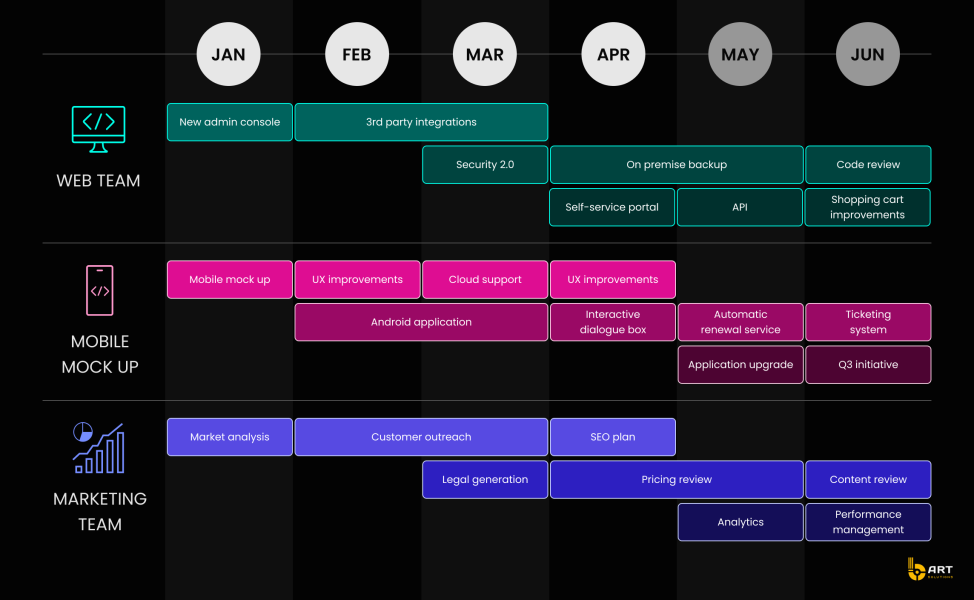Discover our strategic vision of a product roadmap. Learn about our expert guidance and optimal product development approach.
Being lost at the ocean’s width, having so many ways to go but aiming to reach one specific destination. Does that remind you of something? The captain, a product manager in our case, navigating a voyage through the storm (project) by giving directions to the crew (project employees) using maps and compasses (product roadmap and product plan). Such an expedition requires a meticulously planned course and structured foundation.
At the direct parallel lies the significance of a well-structured product roadmap. The product roadmap is your guide in this dynamic expedition toward successful project delivery. It helps to keep your head in the storm, ensuring determined progress in achieving a desired result.
In this article, we will discover the importance of product roadmaps, and outline the right choice of the proper roadmap, not only to reach the goal but also to complete the project with accuracy and persistence.
What Exactly a Product Roadmap is
The definition of a product roadmap goes down to a high-level, strategic document tool that serves as a visual guide and outlines all stages of the product development voyage. The roadmap, at its most basic level, states where you are going and why. It also lays out the team’s strategy for delivering value and serves as a plan for executing the overall product strategy. Product roadmaps give a notion to the stakeholders and team members about the information they need to focus on, their goals, and priorities.
The main objective of a product roadmap is to tie a product’s vision with a company’s business purposes.
Not only does the product crew operate the roadmaps, but stakeholders, executives, sales teams, etc. who use the same guide, understandable to them.
The level of detail in a product roadmap differs because of the stakeholders involved. For instance, it may not be necessary to show investors a product roadmap outlining the programming language or tools that the software engineering team is using.
The most suitable product roadmap probably would be the one where the clients see which product features the engineering team is working on, a possible timeframe, and the goals or objectives of each product release.
Roadmaps vary from simple to complex depending on necessity, but they’re always easy to comprehend and accessible to everyone involved in the product’s development. Relying on your tool of choice, there are potentially over a thousand various product roadmap templates to choose from.
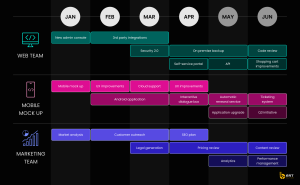
Most Common Types of Product Roadmap
Just like the product itself, product roadmaps have their target audience. Multiple people from different areas of work are connected to the product; thus, it’s crucial to set clear requirements for everyone. The audience factor tells you the type of content to include, its form, and how precise it should be.
Since product roadmaps constantly evolve, they should be flexible and adjustable to the lifecycle of your result, which may shift due to customer needs and market demand.
The best way to choose a roadmap is to look at them all and decide which will lead your journey to its fullest. Combine several of them if you lack certain aspects.
In this section, we will briefly cover 5 of the most useful and the most effective types.
1. Release Roadmap
A release roadmap is probably one of the most used types of roadmaps. It outlines a product’s development timeline and shows what needs to be done, when and who is responsible for delivery. Release roadmap’s role is to plan and track the progress of a product’s development.
Such roadmaps give a clear vision of a project’s progress toward its goals.
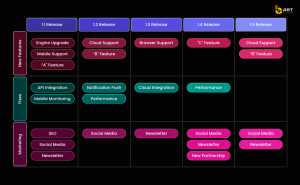
2. Strategy Roadmap
This roadmap shows exactly how a competitive advantage will be obtained in the result. It visualizes the plan for accomplishing goals through specific efforts in a given time frame. It’s a strategic way to brainstorm future opportunities and begin to plan projects for the product team at the same time.
A strategy roadmap is great for showing progress to leadership and keeping functional teams aligned on business strategy.
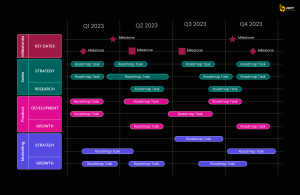
3. Internal & External Product Roadmaps
Internal roadmaps are vital for communication between departments. Typically, designed for executives, production teams, and sales teams, the roadmap helps to stay in sync and make the product conversations within the crew even more effective.
External product roadmaps target external stakeholders and the clients. They avoid internal details, emphasizing the product’s overarching vision and long-term customer benefits, with approximate time frames for major feature releases.
These roadmaps are designed to maximize clarity and visual appeal while highlighting customer benefits without revealing internal complications, focusing on the product’s unique value proposition and market differentiation, and providing a suggested time frame.

4. Timeline Roadmap
Timeline roadmap is also called the now-next-later roadmap. It shows what will be released now, what’s prepared next, and what will be released later. It aims to show priorities in the easiest way possible. This roadmap has several purposes. Firstly, it sets priorities and gives a notion of order for the teams to begin working on the tasks and how much time to spend on them. Secondly, a timeline roadmap signals the executives about when to expect the initiative to be completed.
Timeline roadmaps can be particularly useful for getting a project or process back on track after an obstacle or delay.
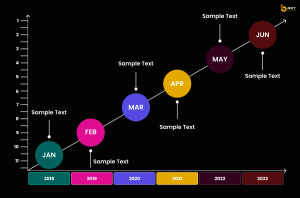
5. Portfolio Roadmap
A portfolio roadmap is a valuable tool for showcasing a company’s overall product strategy and timeline for all its initiatives. It provides a clear picture of multiple product plans on a single roadmap, making it easy for executives and product managers to understand how each product contributes to the overall goals and initiatives. This tool is used to show planned layoffs across multiple products in a single view, making it easier for the team to track progress and stay aligned on the work that matters most. Creating a portfolio roadmap gives visibility to the key areas of strategic investment for products, which is useful for providing a strategic overview of your plan to leadership and a broad view of how multiple product teams work together.
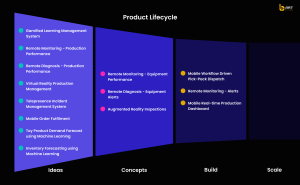
Essential Parts of a Product Roadmap
A product roadmap is created as a result of strategic planning. The details and context vary according to the roadmap features mentioned above.
Selecting your product roadmap content depends on a few aspects: the members who will be viewing the roadmap, a plan for the roadmap, the company’s culture, etc. Before discussing what, items should go into your product roadmap, it is worth thinking about a roadmap’s overall purpose. That will give a better picture for determining what should be included, and why.
All product roadmaps should contain a few key ingredients:
Metrics
Product roadmap metrics are a set of quantitative data accumulated to measure a product roadmap’s performance.
Every team member should be aware of the metrics track during product development, so the team moves towards the same goal.
Product metrics are often grouped into four categories – business metrics, product usage metrics, customer satisfaction, and roadmap progress. Business metrics provide financial and performance insights of the company. Product usage conducts the user’s interaction with product data. Customer satisfaction metrics measure how happy customers are with their experience. Roadmap progress metrics are reference points that show how the product team is progressing through timelines.
Within these categories, there are lots of other different metrics you can track. The “right” way to measure depends on which metrics will be most useful and informative for your team.
Goals
Product roadmap goals are objectives that are measurable, time-bound, and have clearly defined success metrics. They are aimed at representing the essential accomplishments needed to deliver your product. When creating a roadmap, goals serve as a vision for the outcome you aim to create and act as a reference point for the final result you expect to see at the end of the project. The step of coming up with defined goals helps you translate your product strategy into an actionable plan.
Every organization’s goals are unique, and you can develop product-specific, company-oriented, or more generic aims. Ideally, objectives should be measurable and tied to trackable metrics and KPIs. These types of goals will resonate most with the stakeholders. Purposes emphasize the outcomes or results that will drive the business forward. Each measurable goal directly contributes to the broader objectives of the company. These goals guide decision-making and prioritize activities that bring the most value.
Strategy
Strategic planning is a detailed performance plan that identifies and prioritizes key areas of investment to achieve a vision and a specified goal. This required step in creating a roadmap since it considers your business’ mission, vision, and values, which should evolve over time as you dive more into product development. Starting off by building your strategy will clearly frame the business case, which in turn will lead to the team’s objective comprehension.
The lack of a well-created strategy may lead to resource waste, a decreased sense of enthusiasm within the team, moreover, to the goals that will never be achieved.
While working on your strategy, it’s important to involve product team members and stakeholders throughout the process, especially during the inception and development stages.
Timeline
A roadmap timeline works as a visualization of product functionality shown on a timeline. The timescale range can go from days to years, that depends on the amount of work and details involved in a particular release.
They often contain multiple features that get delivered at the same time.
With the set goals, the timescale is broad enough to take drawbacks, retains, or even do-overs into account.
By setting a proper timeline, you will ease the team’s work realization, by accurately meeting the deadline and showing results to the stakeholders.
Having a clear timeframe also helps determine potential challenges or delays that impact the delivery of a part, allowing the team to take measures to solve the issue.
Product Vision
Product vision, as a part of the constellation, that leads you toward the desirable land of success, works as a “north star”, leading your way and outlining your future purpose. Its prior function is centering and concentrating the energy and attention of the entire community. Obviously, it’s not a few efforts achievement, but a long stormy way, sort of a nebulous point in the ocean. With each succeeding product enhancement, your crew gets through a splashy distance.
Most importantly, the product vision answers the “why” questions behind the mission. Without a clear vision, the crew may have trouble seeing the landscape. If they change course and disagree on what to do next, it feels disorienting and demotivating not being able to tie your work to the value it provides. Furthermore, it badly reflects on products and customers, since you can’t produce the experience that users want if you are not precise about why you are providing it.
If done correctly, a product vision inspires and motivates crew members to do their best.
Tips to Create a Product Roadmap
Creating a roadmap mustn’t be the toughest task on earth. Yet you must make it thoughtful and profound. Features like customer needs, business objectives, and market changes are some of the prior things to consider.
Understanding all mentioned above with the technical feasibility of your team and how these align with your company’s goals is essential.
There’s a lot of work that goes into researching what the team should be working on and what the product strategy should be. Often product managers use a combination of roadmap techniques for different parts of the process.
Five Practical Tips for Building a High-Impact Roadmap
- Define Your Audience and Choose the Format
The audience type varies – from executives to marketers to engineers
—and each of them requires a different approach. Executives and salespeople need a high-quality roadmap with timelines for feature releases through multiple products. Engineering teams need a more precise roadmap with tasks broken down by week. The best option, so far, is to tie the roadmap to the audience and create various versions of the roadmap for clients.
The audience you have to present your roadmap to is a predetermining factor for the roadmap’s format, its type, and the content included in it.
The format also makes a tremendous impact on your content choice. The chosen format, suitable for a distinct audience, suggests highlighting the crucial items of data and selecting the themes or goals prioritized on the timeline.
- Set Clear Objectives and Vision
The product vision is the farsightedness of your product. It is a guide and inspiration that provides direction for the result over the settled timeline.
First things first, start by understanding the business objectives that have been set by the organization, such as the company mission and strategy. Understanding the long-term vision will help you clarify what you need to do in the short term.
If objectives aren’t created, start with the picture and outline your product vision and how it helps your business achieve its long-term goals. Doing this ensures your product aligns with your company’s vision and strategy.
Help your team with brainstorming product ideas like writing the vision for your product on a sticky note and placing it in the vision field. Then, brainstorm product ideas.
In addition, if your organization has already set business objectives that need to be reached by the end of the year, it will help you to define the product roadmap and prioritize the product plan. Getting precise on the company objectives will give you hints on where to focus during the product discovery stage.
- Formulate the Strategy
Your next step is to talk to the stakeholders and salespeople, communicating why the changes are necessary and how the roadmap helps with the visualization of the approaching process. Gather information from different sources to estimate the situation in the market and among your competitors. Then define your customer personas. Give the production crew and management an insight into the opinions of the consumer.
After the vision has been accepted by all participants and stakeholders, you will have the data you need to start developing your plan. Don’t forget to profoundly estimate your capabilities. You can also determine which stuff requires the most amount of investment or effort. This will help with further clarification of where you need to focus and drive priorities that are always aligned with your customer value proposition. For each of your prioritized capacities, identify the features that will be required to deliver it. Last but not least, bring it all together into a prioritized strategic roadmap for implementation.
- Choose the Metrics and Tailor Them to the Features
Product metrics play a crucial role in creating a roadmap, with their help you see a whole picture to measure your progress. For a proper metrics choice consider such factors as goals, target audience, and value proposition. This will assist in understanding the expected results for clients and the company to determine the product’s objectives and outcomes. Also, using a framework is great for categorizing metrics into measures like investment, activation, withholding, income, and referral.
Eventually, select quantitative and qualitative metrics. Quantitative metrics show you what happens to the product and users, while qualitative metrics inform you why it happens. A smart thing to do would be to use analytic tools and techniques to collect, store, and analyze data from your product and its users. Feedback tools like surveys, polls, reviews, or ratings can offer insights into user satisfaction.
- Timeline
Every roadmap needs to have certain timeframes to provide an estimate of when the initiatives and features will be delivered. These timeframes aren’t strict but provide an approximate time for when to expect certain features. Breaking the visual timeline into blocks (e.g. weeks, months) and key milestones will help you to better orient with your deadlines and prioritize the tasks as these blocks will serve as reminders. The timeline should be flexible enough to adapt changes and modifications, including checkpoints for better progress reviews and updates.
To estimate your timeframes, you need to consider factors like business priorities, technical complexity, and resource availability, so you need to discuss it with stakeholders before setting deadlines.
Project Plan vs. Product Roadmap: Spot the Difference
Previously, we discovered what the product roadmap actually is. A product plan is another vital component among our voyage essentials.
A project plan serves as a low-level functional document that shows the assignments, resources, and dependencies needed to run your product roadmap. It depicts the scope of work, timetable, budget, and how to manage the threats, issues, and changes that may occur.
This outline is more precise and sectioned, it breaks the product roadmap into actionable steps and assigns roles and responsibilities to the crew members.
A project plan is neatly monitored to track the progress and performance of your project, and smaller in timeframes like up to a few weeks or months.
Let’s take a closer look to compare the two for a better understanding:
So, while the product roadmap is more strategic, cutting your vision into milestones, the project plan, on the other hand, breaks down the work tasks.
A roadmap is created to align the executives and shape the product strategy with regard to evolving market and user needs. Whereas a plan involves the allocation of resources, timelines, and any other restrictions to these tasks.
In contrast to the project roadmap which provides the context and direction for your project plan, the scheme supplies the details and deliverables for your product roadmap.
One of the main differences is that the project roadmap is compared to the picture as a whole, taking all the details in the project plan and spotlighting the most important factors relevant to all stakeholders. The project plan shows that every aspect of the project, such as the client, specific training requirements, and schedules, has been entirely considered and planned. should also address all the details of your project.
Project Plan vs. Product Roadmap: How are they Related
Like smooth waves of the ocean product roadmap and a project plan are harmonizing tools serving various purposes and audiences.
To keep things settled, a product roadmap enables to define and deliver the why, what, when, and who of your product, while a project plan helps to determine and manage the how, and where of the project. A product roadmap and a project plan must be aligned and agreed upon with each other, but flexible and adjustable to changes at the same time in demand, client needs, and business prerogatives.
To recap, the product plan provides an overall strategy and context for the product, while the product roadmap turns that strategy into effective steps, timelines, and deliverables. Together, they form a close-knit framework for navigating the development process and success of a product.
Agile Product Roadmaps
An agile roadmap is considered to be a high-level strategic planning tool of action for achieving your product vision and expected evolution. In other words, the roadmap is where vision meets strategy. An agile roadmap is special because it prioritizes outcomes over outputs, focusing mainly on achieving goals and solving customer issues rather than delivering an established set of features. The components included involve product releases, and features — show how each contributes to the product strategy.
An interesting thing about agile product roadmaps is that the sense of deadlines is rather contradictory. On the one hand, it erases the frames of product deadlines, but on the other hand, still maintains the concept of time not tailoring to a specific date. So basically, it outlines general time frames for the main themes of work — what is planned to be delivered and when.
Agile roadmaps function as a communication tool between product teams and delivery crews and get buy-in from key stakeholders.
Agile roadmaps are most useful when you are working on something from scratch like a new version of an application, a new feature, or a new product. For this, your team needs a plan that answers all “Why” questions and visualizes the outcome.
Creating an agile product roadmap will help you visualize the multifunctional work required to create a product or enhancement for bringing it out to the market. Showing high-level goals and a closer-term plan for the upcoming work also depends on the level of detail you are willing to seize. Let the agile roadmap be another guide to measure progress, make better decisions, and eventually provide more value for customers.
To Conclude
Let these concluding ideas be a compass, as you step away, guiding as lanterns, lighting the path of your interesting voyage. Product roadmaps are mostly used by product managers and inform the stakeholders and team members about the details they need to concentrate on, their objectives, and priorities. Among the vast diversity of roadmaps, each team (sales, developer, executives) may benefit by choosing the specific type out of a variety of product roadmaps, even mixing different styles together for a better result. Product roadmaps should remain agile and ready to be adjusted to upcoming issues, unlike project plan which should remain profound and stable.
By adopting strategic approaches, using an agile roadmap, and following the helpful tips, create your own product roadmap that brings innovations, aligns teams, and drives your product toward success.
Now you are all equipped to create an effective product roadmap and ready to set sail. Using this guide will bring the most value to your customers and will help to keep your crew aligned on the land aimed. The process of creating a product roadmap is dynamic and requires tight collaboration, strategic thinking, and effective communication.
Keep in mind that the prior function of the product roadmap is to guide your voyage and your crew members all over the product development process to achieve the product vision and goals.
